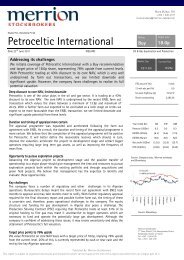Quarterly Bulletin Q3 2013
Quarterly Bulletin Q3 2013
Quarterly Bulletin Q3 2013
Create successful ePaper yourself
Turn your PDF publications into a flip-book with our unique Google optimized e-Paper software.
66<br />
Developments in the International<br />
<strong>Quarterly</strong> <strong>Bulletin</strong> 03 / July 13<br />
and Euro Area Economy<br />
Box B: Comparing household saving patterns in the euro area periphery against those in the rest of the<br />
euro area<br />
By David Purdue<br />
The basis for this analysis is the financial accounts relation: 4<br />
Savings = Transactions in Financial Assets – Transactions in Financial Liabilities<br />
+ Gross Fixed Capital Formation + (Statistical discrepancy and Other)<br />
The relation shows the three “forms of saving”. Firstly, a household can save through acquiring<br />
financial assets (such as deposits, securities, equities) thereby foregoing current consumption<br />
for future consumption. Secondly, households can invest in the real economy which would<br />
increase gross fixed capital formation. This is, for the most part, made up of the acquisition of<br />
property. Finally, households can choose to pay down debt accumulated in previous periods.<br />
Positive values for financial liabilities transactions (which are shown with an inverse sign in Chart<br />
2) indicate loan advancement to households and contribute negatively to savings. However, as<br />
the sector looks to deleverage, financial liabilities transactions will decrease and can even turn<br />
negative with savings increasing as a result.<br />
Box B Chart 2: Euro Area Periphery - Saving<br />
Four Quarter Accumulated Sum<br />
Box B Chart 3: Rest of the Euro Area - Saving<br />
Four Quarter Accumulated Sum<br />
1000<br />
€ bn € bn<br />
700<br />
1000<br />
€ bn € bn<br />
700<br />
800<br />
600<br />
800<br />
600<br />
600<br />
500<br />
600<br />
500<br />
400<br />
400<br />
400<br />
400<br />
200<br />
300<br />
200<br />
300<br />
0<br />
200<br />
0<br />
200<br />
-200<br />
100<br />
-200<br />
100<br />
-400<br />
0<br />
-400<br />
0<br />
Q1 <strong>Q3</strong> Q1 <strong>Q3</strong> Q1 <strong>Q3</strong> Q1 <strong>Q3</strong> Q1 <strong>Q3</strong> Q1 <strong>Q3</strong> Q1 <strong>Q3</strong> Q1 <strong>Q3</strong> Q1 <strong>Q3</strong> Q1 <strong>Q3</strong><br />
Q1 <strong>Q3</strong> Q1 <strong>Q3</strong> Q1 <strong>Q3</strong> Q1 <strong>Q3</strong> Q1 <strong>Q3</strong> Q1 <strong>Q3</strong> Q1 <strong>Q3</strong> Q1 <strong>Q3</strong> Q1 <strong>Q3</strong> Q1 <strong>Q3</strong><br />
2003 2004 2005 2006 2007 2008 2009 2010 2011 2012<br />
2003 2004 2005 2006 2007 2008 2009 2010 2011 2012<br />
Financial Liabilities Transactions<br />
Financial Assets Transactions<br />
Gross Fixed Capital Formation<br />
Statistical Discrepancy and Other<br />
Savings (RHS)<br />
Financial Liabilities Transactions<br />
Financial Assets Transactions<br />
Gross Fixed Capital Formation<br />
Statistical Discrepancy and Other<br />
Savings (RHS)<br />
Source: ECB SDW Website.<br />
Source: ECB SDW Website.<br />
From the start of 2007 to the end of 2009, a rise in savings is evident in both areas (Chart 2). The<br />
increases stem from severe drops in financial liabilities transactions of €238 billion (periphery) and<br />
€146 billion (rest of the euro area) and occurred despite lower financial asset transactions and<br />
gross fixed capital formation. On a four quarter accumulated sum basis, the periphery savings<br />
increased by €53 billion while the rest of the euro area component increased by €71 billion.<br />
Although the rest of the euro area savings increase is larger in absolute terms, the changes<br />
observed in the periphery are larger in percentage terms for all components during the period.<br />
The periphery saw declines of 95.2 per cent in financial liabilities transactions, 62.6 per cent in<br />
financial assets transactions and 24.2 per cent in gross fixed capital formation. By contrast, the<br />
corresponding declines in the rest of the euro area were 57.6 per cent, 0.3 per cent and 6.4 per<br />
cent, respectively.<br />
4 The accounting items net capital transfers, changes in inventories and acquisitions less disposals of valuables and<br />
acquisitions less disposals of non-produced non-financial assets are aggregated in “Other”. The statistical discrepancy<br />
relates to the difference between calculating savings from a financial accounts perspective (as we are here) or from a nonfinancial<br />
perspective i.e. savings equals disposable income minus consumption.




